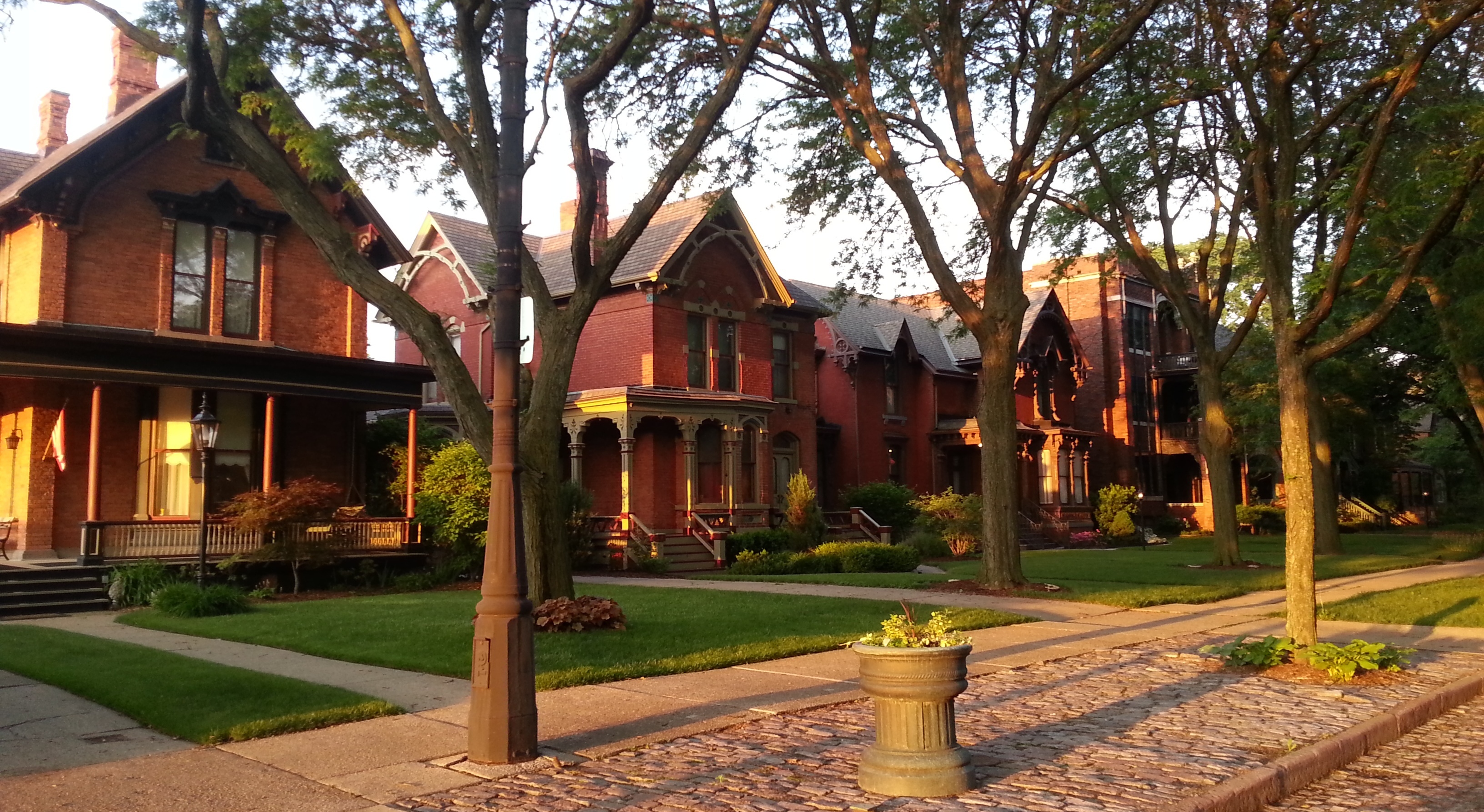Welcome to the website of the West Canfield Historic District, located in Detroit, MI.
Our Historic District is the only block in Detroit that is lined on both sides with well preserved Victorian homes. The street itself is a reconstructed granite block street of original width with sandstone curbs and broad sidewalks lined with shade trees that now nearly arch over the street.
Where the Indian Village District and Boston-Edison Districts reflect the automobile-era prosperity of Detroit, our District shows the prosperous appearance of pre-automobile Detroit, dating from 1871 to 1900. It is the prosperity of the middle management level of Detroit that you see here. The upper class mansions of that era were located in Brush Park on the edge of downtown. Their ballrooms and servant quarters were a maintenance burden too great for survival in all but a few isolated examples. But our houses were middle-management houses at the edge of the city, a mere twenty minute carriage ride from downtown, and much more adaptable to modern life. Many of us still have a carriage house, converted from horse stable to attractive rental unit in the back garden.
As Detroit moved into the motor age, Canfield was widened from 100 feet to 200 feet, making it into a major cross-town avenue. Then in the 1950's the Lodge and Chrysler freeways were built without a bridge across them at Canfield, severing its cross-town function, and leaving our neighborhood with an abnormally wide street almost devoid of traffic. After the Historic District was formed, we obtained a grant from the U.S. Department of Housing and Urban Development to restore our streetscape to its original appearance, 100 feet wide with generous berms between the sidewalk and the pavement, where trees could grow and again line the street, as could be seen in old photographs. This project was finished in 1975, using granite paving blocks from old Atwater Street (now beneath the Renaissance Center). In fact, Canfield residents provided the labor of loading these blocks onto trucks and moving them for storage to Ft. Wayne. Finally, with our HUD grant, we were able to have them reinstalled, along with sandstone curbs salvaged from various places in the city. Detroit provided young honey locust trees that now line the street in double rows along each sidewalk, almost completely arching over the street in places, now 40 years later. The Historic District Association collected $6000 for a bronze replica of an old Detrot horse fountain, made at the Wayne State Sculpture Foundry from a model in the Detroit Historic Museum, and now installed on the street. For many years the City provided flowing water for it and many Police horses came to drink from it at the end of each day. Today, unfortunately, it serves only as a decorative planter.
We invite the public to visit us for a glimpse of Detroit's past middle-class prosperity, carefully maintained and landscaped by private ownership of these historic residences.
Where the Indian Village District and Boston-Edison Districts reflect the automobile-era prosperity of Detroit, our District shows the prosperous appearance of pre-automobile Detroit, dating from 1871 to 1900. It is the prosperity of the middle management level of Detroit that you see here. The upper class mansions of that era were located in Brush Park on the edge of downtown. Their ballrooms and servant quarters were a maintenance burden too great for survival in all but a few isolated examples. But our houses were middle-management houses at the edge of the city, a mere twenty minute carriage ride from downtown, and much more adaptable to modern life. Many of us still have a carriage house, converted from horse stable to attractive rental unit in the back garden.
As Detroit moved into the motor age, Canfield was widened from 100 feet to 200 feet, making it into a major cross-town avenue. Then in the 1950's the Lodge and Chrysler freeways were built without a bridge across them at Canfield, severing its cross-town function, and leaving our neighborhood with an abnormally wide street almost devoid of traffic. After the Historic District was formed, we obtained a grant from the U.S. Department of Housing and Urban Development to restore our streetscape to its original appearance, 100 feet wide with generous berms between the sidewalk and the pavement, where trees could grow and again line the street, as could be seen in old photographs. This project was finished in 1975, using granite paving blocks from old Atwater Street (now beneath the Renaissance Center). In fact, Canfield residents provided the labor of loading these blocks onto trucks and moving them for storage to Ft. Wayne. Finally, with our HUD grant, we were able to have them reinstalled, along with sandstone curbs salvaged from various places in the city. Detroit provided young honey locust trees that now line the street in double rows along each sidewalk, almost completely arching over the street in places, now 40 years later. The Historic District Association collected $6000 for a bronze replica of an old Detrot horse fountain, made at the Wayne State Sculpture Foundry from a model in the Detroit Historic Museum, and now installed on the street. For many years the City provided flowing water for it and many Police horses came to drink from it at the end of each day. Today, unfortunately, it serves only as a decorative planter.
We invite the public to visit us for a glimpse of Detroit's past middle-class prosperity, carefully maintained and landscaped by private ownership of these historic residences.





